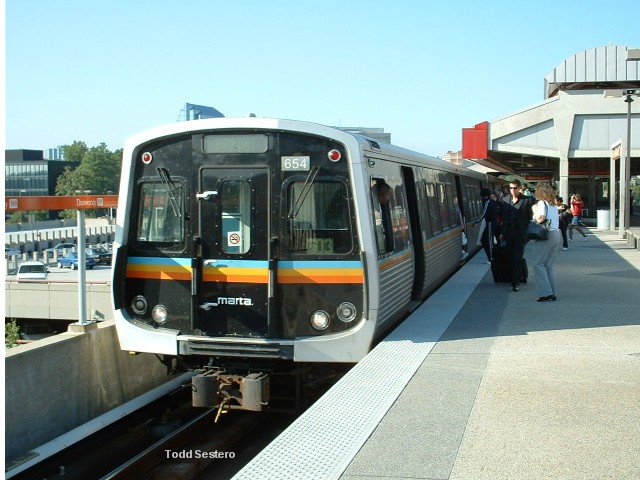
SB train at the Dunwoody station.
RAILFAN GUIDES of the U.S.
Todd's Railfan Guide to the
MARTA METRO
SYSTEM
ATLANTA GA

SB train at the Dunwoody station.
Maps
Background and History
Signals
Misc Signal Shots
Trains, Busses, Etc
Electrical and Other Equipment
Stations
Signs
Track and Switches
RAILFAN GUIDES HOME
RAILROAD SIGNALS HOME

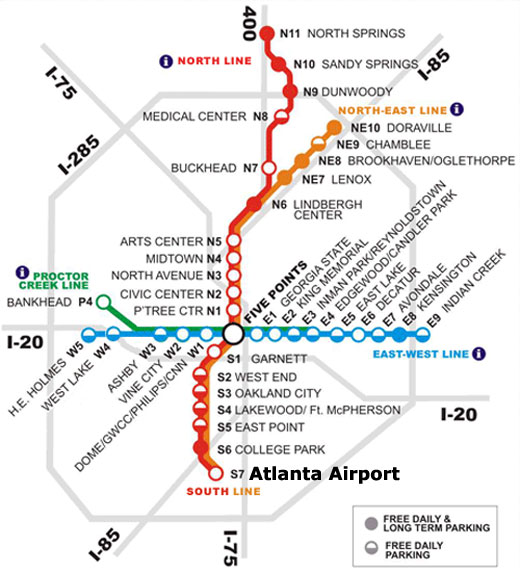
MARTA began it's heavy rail operation on June 30th, 1979. Construction of the system began in 1975.
The system has approximately 47.6 miles (76.6km) of track, with 38 stations. All stations are in DeKalb and Fulton counties, except for the Hartsfield-Jackson Atlanta Airport station which is in Clayton County.
Like many other heavy rail systems, the MARTA system is a combination of elevated, underground, and surface running. The deepest underground station is the Peachtree Center Station, located 120 feet (36 meters) underground. An interesting note about the Peachtree station is that the designers decided to leave the exposed rock walls "au natural" as a tribute to the hard work it took to dig and blast through the hard rock prevalent in the area.
The system has 4 lines: Red (North-South), Blue (East-West), Gold (Northeast-South), and Green (Proctor Creek), and the Five Points station is the only one common to them all. MARTA switched over to a color based ID scheme in October of 2009.
Trains run under ATC, Automatic Train Control, with operators being used to make announcements, operate doors, and run the trains in the event of an emergency or ATC failure, like many other heavy rail systems (Baltimore and DC come to mind).
The system has three service facilities / yards as noted on my map.
MARTA has it's own 300 strong police department, and they can arrest you.
Photography is permitted on the property if you get permission in advance, as I've noted below. Their website also states that no pictures of the system shall be used anywhere, including the internet..... one policy which is very difficult to control considering freedom of the press and lack of control over what is photographed from public property. Side Note: Many transit systems have a similar NO PHOTOGRAPHY policy on their property.... like Boston.... Baltimore does not however (altho you can be asked why you're taking pictures by any employee). New York allows photography too if you get permission, but you have to go to Brooklyn to their HQ for that little piece of paper.
MARTA itself was "formed" on February 17th, 1972, with bus service only, having bought out the Atlanta Transit Company.
Marta use two, three, and four aspect signals,
all of which have been converted to LED's.
The signals have 5 aspects:
Flashing green, steady green, yellow, red, and lunar white:
:
Proceed with cab signals over switch normal or into normal traffic direction.
STEADY GREEN:
Proceed with cab signals over switch reversed.
YELLOW:
Proceed to next signal, preparing to stop.
RED:
Stop
LUNAR WHITE:
Proceed being prepared to stop due to train ahead or other obstruction.
Two Aspect signals are red and green.
Three aspect signals come in two varieties:
Red/yellow/green used on mainline.
Red/lunar white/yellow is used in yards.
Four aspect signals are red/lunar white/yellow/green
Notice that Marta does not use the standard railroad "red on bottom" arrangement.
2 Color
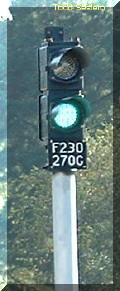
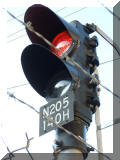
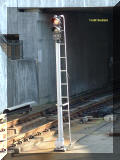
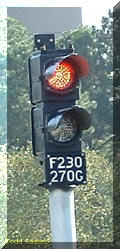
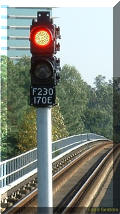
 2 color signals protecting the crossover at
Avondale on the east side of the station.
2 color signals protecting the crossover at
Avondale on the east side of the station.
3 Color
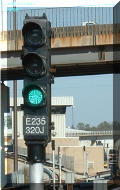
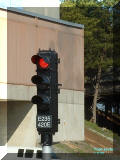
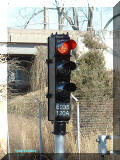
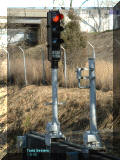


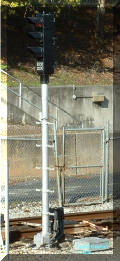
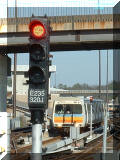 Needed are shots of the 3
color signals used in the yard!
Needed are shots of the 3
color signals used in the yard!
4 Color
If anyone has some good shots of the four color signals, it sure would be appreciated
Dwell Signals
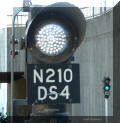
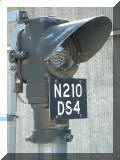

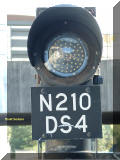

Marta uses the above signal, which it calls a
DWELL SIGNAL,
to inform the operator of the train how long he has to keep the doors open.
These signals remain steady for approx. 15 seconds,
indicating the open period for the doors, and then it flashes for 5 seconds,
after which the operator is supposed to depart the station. The signal is otherwise dark until the train comes to
a stop.
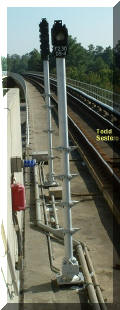


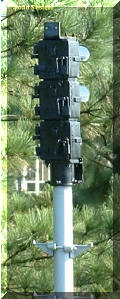

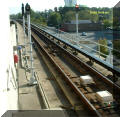
Other general shots of signals at Lindbergh, plus
a rear shot of a 3 aspect signal - best I could do with my 70 minute visit!
 A SB train
coming into the station at Lindbergh.
A SB train
coming into the station at Lindbergh.
 A bus outside
the Lindbergh station.
A bus outside
the Lindbergh station.
 A shot from the pedestrian overpass at the
Avondale station, looking towards the yard.
A shot from the pedestrian overpass at the
Avondale station, looking towards the yard.
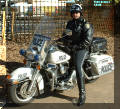 A motorcycle cop at Avondale. They will
come after you if seen taking pictures on the property, and operators are
instructed to report photographers. There is an office complex at the
Avondale yard (off Ponce de Leon Ave.), where you can supposedly go in and
request permission to take pictures. I don't know how much of a hassle
they will give you. If you have the time and are there during the day, I
would recommend it, otherwise you will be hassled as I was. I'm not sure
if the other two yards have the same office available to check-in at.
A motorcycle cop at Avondale. They will
come after you if seen taking pictures on the property, and operators are
instructed to report photographers. There is an office complex at the
Avondale yard (off Ponce de Leon Ave.), where you can supposedly go in and
request permission to take pictures. I don't know how much of a hassle
they will give you. If you have the time and are there during the day, I
would recommend it, otherwise you will be hassled as I was. I'm not sure
if the other two yards have the same office available to check-in at.
Electrical and Other Equipment
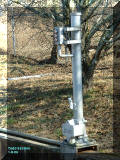 Route selector box on the eastbound track at
Avondale.
Route selector box on the eastbound track at
Avondale.
 A call box next to an eastbound signal at
Avondale.
A call box next to an eastbound signal at
Avondale.

 A couple shots of the mechanical trip stops used
at the entrance to the yard at Avondale.
A couple shots of the mechanical trip stops used
at the entrance to the yard at Avondale.
The sensor on the truck is "behind" the 750VDC pick-up shoe (about 10ft from the
front of the car), so the train can advance "beyond" the signal a fair bit
before the train is stopped - on New York subway cars, the sensor is placed
under the front of the car.
 This
is a "marker coil", and is used to tell the train where to stop for the station.
This
is a "marker coil", and is used to tell the train where to stop for the station.
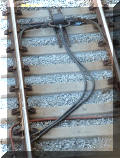

These two pictures depict impedance
bonds used by the ATP system to get the control signals "into" to the rails, The
Baltimore Light Rail System now has the same "stuff" cluttering up the
R-O-W.
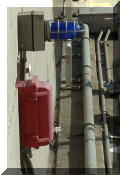

Seems like all heavy rail systems have blue
lights like this, anyone know what Marta uses them to signify?
A well worn "Danger - High Voltage" sticker of the 3rd rail cover.
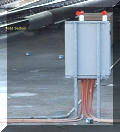

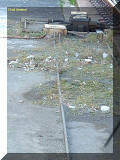
A few shots of electrical boxes and the conduit
running on the ground.
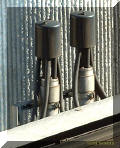
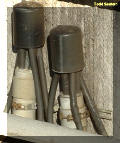
These are called "potheads" - they are just
covers for splices in the DC traction power feed.

A busy photo -- signal base, ladder and bracket,
junction box, drain, 3rd rail, and air hose.


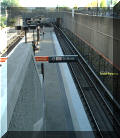
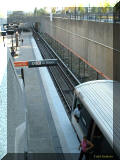


Some shots of the Lindbergh station on the north
side of
Atlanta.
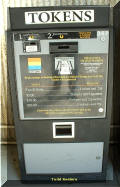
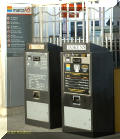
Couple of shots of the token machines.
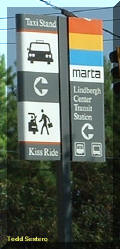
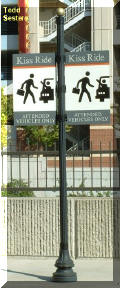
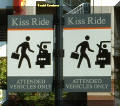
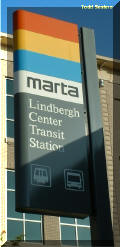
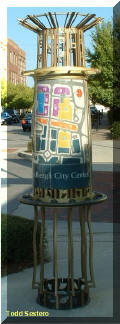
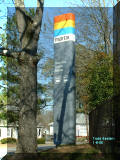
Some signs from around the Lindbergh station................................................................
Sign outside Avondale.




A few shots of the rail and 3rd rail.


A couple of shots of
the 3rd track at the south end of the Lindbergh platform, where I'm guessing the
center track goes into the yard (didn't have time to ride south to find out).
 A nice shot off the east side platform at
Avondale, showing the yard tower, and the two yard flyovers.
A nice shot off the east side platform at
Avondale, showing the yard tower, and the two yard flyovers.
Disclaimers:
I love trains, and I love signals. I am not an expert. My webpages reflect what I find on the topic of the page. This is something I have fun with while trying to help others. My webpages are an attempt at putting everything I can find of the subject in one convenient place. There are plenty of other good websites to help me in this effort, and they are listed in the links section on my indexa page, or as needed on individual pages. Please do not write to me about something that may be incorrect, and then hound the heck out of me if I do not respond to you in the manner you would like. I operate on the "Golden Rule Principle", and if you are not familiar with it, please acquaint yourself with how to treat people by reading Mathew 7:12 (among others, the principle exists in almost every religion). If you contact me (like some do, hi Paul) and try to make it a "non-fun" thing and start with the name calling, your name will go into my spambox list! :-)
Please Note: Since the main focus of my two websites is railroad signals, the railfan guides are oriented towards the signal fan being able to locate them. For those of you into the modeling aspect of our hobby, my indexa page has a list of almost everything railroad oriented I can think of to provide you with at least a few pictures to help you detail your pike.
If this is a railfan page, every effort has been made to make sure that the information contained on this map and in this railfan guide is correct. Once in a while, an error may creep in, especially if restaurants or gas stations open, close, or change names. Most of my maps are a result of personal observation after visiting these locations. I have always felt that a picture is worth a thousand words", and I feel annotated maps such as the ones I work up do the same justice for the railfan over a simple text description of the area. Since the main focus of my website is railroad signals, the railfan guides are oriented towards the signal fan being able to locate them. Since most of us railheads don't have just trains as a hobby, I have also tried to point out where other interesting sites of the area are.... things like fire stations, neat bridges, or other significant historical or geographical feature. While some may feel they shouldn't be included, these other things tend to make MY trips a lot more interesting.... stuff like where the C&O Canal has a bridge going over a river (the Monocacy Aqueduct) between Point of Rocks and Gaithersburg MD, it's way cool to realize this bridge to support a water "road" over a river was built in the 1830's!!!
My philosophy: Pictures and maps are worth a
thousand words, especially for railfanning. Text descriptions only
get you so far, especially if you get lost or disoriented. Take
along good maps.... a GPS is OK to get somewhere, but maps are still
better if you get lost! I belong to AAA, which allows you to get
local maps for free when you visit the local branches. ADC puts
out a nice series of county maps for the Washington DC area, but their
state maps do not have the railroads on them. If you can find em,
I like the National Geographic map book of the U.S..... good, clear, and
concise graphics, and they do a really good job of showing you where
tourist type attractions are, although they too lack the railroads.
Other notes about specific areas will show up on that page if known.
Pictures and additional information is always needed if anyone feels
inclined to take 'em, send 'em, and share 'em, or if you have
something to add or correct.... credit is always given! BE NICE!!! Contact info
is here
Beware: If used as a source, ANYTHING from Wikipedia must be treated as being possibly being inaccurate, wrong, or not true.
RAILFAN GUIDES HOME
RAILROAD SIGNALS HOME
New 10/6/06
Last Modified:
24-May-2014